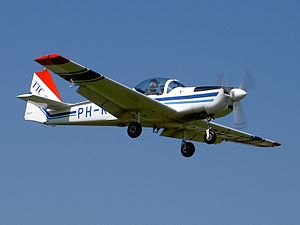| RF-6, T67 Firefly | |
|---|---|
 Slingsby T67M260 Firefly | |
| General information | |
| Type | Trainer/tourer/sport aircraft |
| Manufacturer | Fournier Slingsby Aviation |
| Status | Limited Service |
| Primary users | Royal Jordanian Air Force |
| Number built | > 250 |
| History | |
| Manufactured | 1974–1995 |
| First flight | 12 March 1974 |
| Developed into | Sportavia RS-180 |
The Slingsby T67 Firefly, originally produced as the Fournier RF-6, is a two-seat aerobatic training aircraft, built by Slingsby Aviation in Kirkbymoorside, Yorkshire, England.[1]
It has been used as a trainer aircraft by several armed forces, as well as civilian operators. In the mid-1990s, the aircraft became controversial in the United States after three fatal accidents during US Air Force training operations. The Firefly has poor spin recovery, and has been involved in at least 36 fatal accidents.[2]
- ^ "Slingsby T67 Firefly". Marshall Slingsby. Archived from the original on 30 July 2012. Retrieved 18 June 2012.
- ^ Robinette, Rob. "The T-3 and Me". robrobinette.com. Retrieved 17 February 2022.
The T-3 was a relatively unforgiving aircraft that would snap roll (flick) with very little rudder displacement accompanied with ANY stall buffet. This and the very nose low/high spin rate spin mode are the primary reasons the Slingsby T67M/T-3A has such a terrible safety record--over 14% of the T-67 fleet has been destroyed in fatal accidents. The T-3's typical spin entry was a snap roll with the aircraft going completely inverted during the first turn which was very disorienting for new pilots. The aircraft would not recover from a spin if you released the flight controls--it would actually wrap up and spin faster with the nose even lower than normal. The T-3 did spin very nose low--so low you had to look way up to see the horizon. It also spun very fast. It was nothing like the T-37 spin, nothing at all. The T-3 spun so fast that at spin recovery your eyes would go into nystagmus (your eyeballs bounce back and forth). The high altitude of Academy spin training--we entered all spins between 11,500 to 12,000 feet above mean sea level--did affect the way the aircraft spun and recovered. The thinner the air the less the flight control surfaces have to work with during a spin recovery. I believe this is one of the reasons all the spin accidents occurred at the Academy.